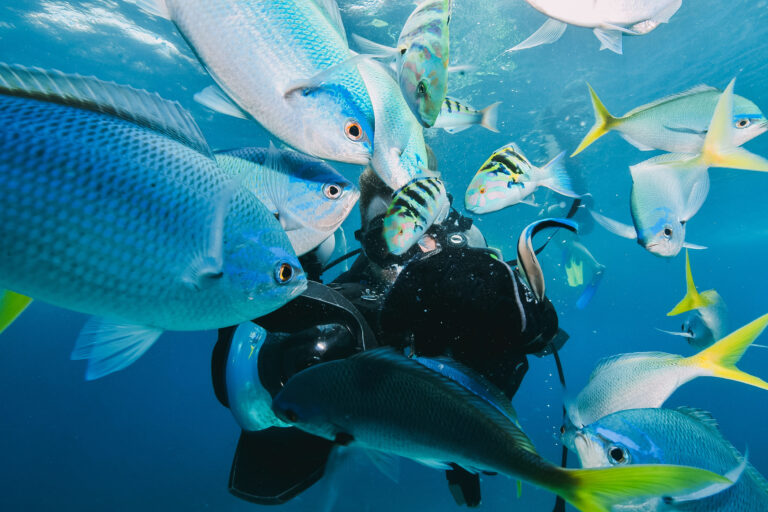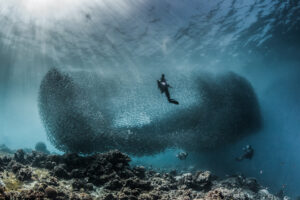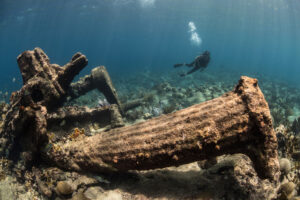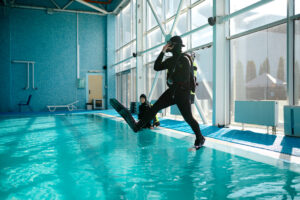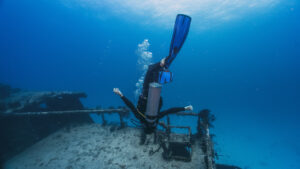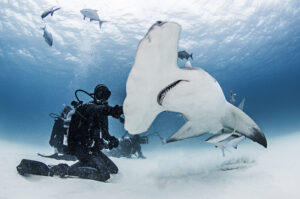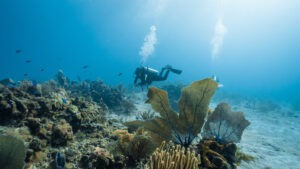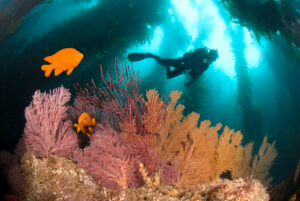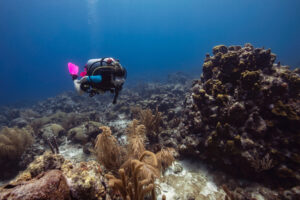What is Travel Gas?
Travel gas is a critical component in the world of scuba diving, particularly in the practice of technical diving. This term refers to a specific mixture of gases used by divers to ensure safe and efficient ascents and descents. Unlike recreational diving, which typically involves straightforward gas mixtures like air or enriched air nitrox, technical diving requires more complex planning and gas management. Travel gas plays a vital role in mitigating the risks associated with deep and extended dives, such as decompression sickness and nitrogen narcosis. Understanding its composition, planning, and application is essential for divers aiming to extend their underwater capabilities safely.
Definition and Purpose of Travel Gas
Travel gas is defined as a breathing gas mixture used by divers during the transition phases of a dive, particularly between the surface and the deeper parts of the dive. It is distinct from the bottom gas, which is used at the deepest part of the dive, and decompression gases, which are used during ascent to off-gas inert gases safely. The primary purpose of travel gas is to manage the physiological challenges posed by depth and pressure changes, thereby ensuring the diver’s safety throughout the dive.
The use of travel gas helps reduce the risk of decompression sickness by allowing divers to switch to gases with different inert gas proportions at varying depths. This strategic gas switching helps manage the inert gas load in the diver’s tissues, facilitating safer ascents and minimizing the risk of bubble formation in the body. Travel gas also helps mitigate the effects of nitrogen narcosis, a condition that impairs cognitive and motor functions due to high nitrogen pressure at depth. By using gas mixtures with lower nitrogen content, divers can maintain clearer thinking and better motor skills at greater depths.
Compared to other types of breathing gases, travel gas is specifically tailored to the needs of transition phases in a dive. While bottom gas is optimized for maximum depth and decompression gases for ascent, travel gas is balanced to provide sufficient oxygen while reducing nitrogen and sometimes incorporating helium to manage narcosis. This careful calibration of gas mixtures underscores the importance of travel gas in technical diving.
Components of Travel Gas
Travel gas typically comprises a mixture of oxygen, nitrogen, and helium, each contributing to the diver’s safety and performance underwater. Oxygen is crucial for sustaining life, but its partial pressure must be carefully managed to avoid toxicity at depth. Nitrogen, while a major component of air, can cause narcosis at higher pressures, thus its proportion is often reduced in travel gas mixtures. Helium is introduced to reduce the overall narcosis effect, as it is less narcotic than nitrogen.
The exact proportions of these gases in a travel gas mixture depend on the planned depth and duration of the dive. A common mixture might involve higher oxygen content at shallower depths to ensure adequate physiological function, while deeper depths might necessitate a reduction in oxygen and nitrogen, with a corresponding increase in helium. For instance, a travel gas mixture used at moderate depths might contain 30% oxygen, 30% nitrogen, and 40% helium, while deeper dives might require even higher helium content to counteract narcosis.
Managing these components is critical. Oxygen toxicity becomes a concern when partial pressures exceed safe limits, which can lead to convulsions and other severe health issues underwater. Nitrogen, while generally inert, can impair mental function at depth. Helium, although expensive and sometimes logistically challenging to obtain, is invaluable for its ability to reduce narcosis and improve clarity of thought and motor function at depth. Therefore, the composition of travel gas must be meticulously planned and tailored to the specific needs of each dive.
Planning and Calculations
The planning and calculation of travel gas mixtures are fundamental aspects of technical diving. Divers must consider various factors, including depth, dive time, and decompression requirements, to formulate the appropriate gas mixture. The process involves detailed pre-dive planning and the use of mathematical models and dive tables to ensure safety and efficiency.
Depth is a primary consideration when planning travel gas. Divers must calculate the partial pressures of oxygen and other gases to ensure they remain within safe limits throughout the dive. For example, at a depth of 30 meters (98.4 feet), the partial pressure of oxygen in a gas mixture must be carefully controlled to avoid oxygen toxicity. Dive tables and dive planning software are often used to determine the optimal gas mixture for these conditions.
Time is another crucial factor. The duration of the dive influences the amount of inert gas absorbed by the diver’s tissues. Longer dives require more careful management of decompression to avoid the formation of bubbles during ascent. This involves calculating the no-decompression limits and planning gas switches at appropriate depths to facilitate safe decompression. Divers often use dive computers and software to model these scenarios and adjust their gas mixtures accordingly.
Mathematical models play a significant role in these calculations. Algorithms such as Bühlmann and VPM-B (Variable Permeability Model) are used to simulate the absorption and elimination of inert gases in the body. These models help divers plan their gas mixtures and decompression schedules, ensuring that they can switch to travel gas at the right times to minimize the risk of decompression sickness. By integrating these models into their planning, divers can optimize their gas mixtures for each phase of the dive, enhancing both safety and performance.
Operational Considerations
Using travel gas involves specific operational considerations to ensure the safety and efficiency of the dive. Equipment requirements, storage, handling, and safety protocols are all critical aspects that divers must address to use travel gas effectively.
The equipment needed for using travel gas includes multiple cylinders and regulators, each dedicated to different gas mixtures. Divers typically carry these cylinders slung at their sides or mounted on their back. Each cylinder is clearly labeled with the gas mixture it contains, and the regulators are color-coded or marked to prevent accidental switching to the wrong gas. Divers must be proficient in managing these multiple cylinders and regulators, switching gases smoothly and accurately during the dive.
Storage and handling of travel gas require meticulous care. Gas mixtures must be precisely blended and tested to ensure they meet the required specifications. This often involves the use of specialized gas blending equipment and analyzers to verify the composition of the gas. Cylinders must be stored in a cool, dry place and regularly inspected for integrity and pressure. Handling protocols must be followed to prevent contamination and ensure that the gas remains pure and effective.
Safety protocols for switching gases during a dive are paramount. Divers must be trained to recognize the appropriate depth and conditions for each gas switch. They use depth gauges and dive computers to monitor their progress and ensure they switch gases at the correct points in the dive plan. Communication with dive buddies and surface support teams is also crucial to ensure that everyone is aware of the gas switching procedures and can assist if any issues arise. These operational considerations are essential to the safe and effective use of travel gas in technical diving.
Practical Applications
The practical applications of travel gas extend across various types of diving, enhancing safety and performance in challenging underwater environments. Technical diving, cave diving, wreck diving, and commercial diving operations all benefit from the use of travel gas to manage depth and decompression.
In technical diving, travel gas is essential for dives that exceed the limits of recreational diving. For example, a deep dive to explore a shipwreck at 60 meters (196.9 feet) requires careful management of gas mixtures to avoid narcosis and ensure a safe ascent. Travel gas allows divers to extend their bottom time and conduct thorough explorations while maintaining safety. Case studies of deep wreck explorations often highlight the critical role of travel gas in achieving successful dives.
Cave diving is another area where travel gas is indispensable. The confined spaces and extended durations typical of cave dives demand meticulous gas management. Divers use travel gas to transition between the surface and the deeper parts of the cave system, ensuring they have the appropriate gas mixtures for different depths. This practice is crucial for preventing decompression sickness and managing the risks associated with prolonged exposure to high-pressure environments.
In commercial diving operations, travel gas is used to support tasks such as underwater construction, inspection, and maintenance. These activities often involve extended bottom times and significant depth, requiring careful planning and use of travel gas to ensure the safety and efficiency of the divers. The use of travel gas in these contexts allows commercial divers to perform complex tasks while minimizing the risks associated with deep and prolonged dives.
Challenges and Limitations
Despite its benefits, the use of travel gas presents several challenges and limitations that divers must navigate. Potential risks, limitations in depth and duration, and technological and training barriers all impact the effective use of travel gas.
One of the primary risks associated with travel gas is the potential for gas switching errors. Incorrectly switching to the wrong gas mixture at depth can have severe consequences, including oxygen toxicity or nitrogen narcosis. Divers must be well-trained and highly attentive to their gas switching procedures to avoid these risks. Additionally, equipment malfunctions or mislabeling of cylinders can lead to dangerous situations, underscoring the importance of rigorous equipment checks and maintenance.
The limitations in depth and duration are also significant. While travel gas extends the range of technical diving, there are still constraints on how deep and how long divers can safely remain underwater. The physiological limits of the human body, combined with the logistical challenges of managing multiple gas mixtures, impose practical limits on diving operations. For instance, dives beyond 100 meters (328.1 feet) require exceptionally careful planning and the use of advanced gas mixtures, which can be logistically and technically challenging to manage.
Technological and training barriers further impact the use of travel gas. Advanced gas blending equipment and dive computers are essential for planning and executing dives using travel gas, but these tools require significant investment and expertise. Divers must undergo specialized training to use travel gas effectively, including courses on gas blending, decompression theory, and advanced diving techniques. Access to this training and technology can be a limiting factor for some divers, affecting their ability to safely use travel gas.
Key Takeaways
Travel gas is a crucial element in technical diving, providing a tailored mixture of gases to manage depth and decompression safely. Understanding its composition, planning,
and operational considerations is essential for divers aiming to extend their underwater capabilities. Despite the challenges and limitations, the use of travel gas enhances safety and performance in a variety of diving applications, from deep wreck explorations to commercial underwater tasks. As diving technology and training continue to advance, the role of travel gas will likely expand, offering new possibilities for underwater exploration and work.

